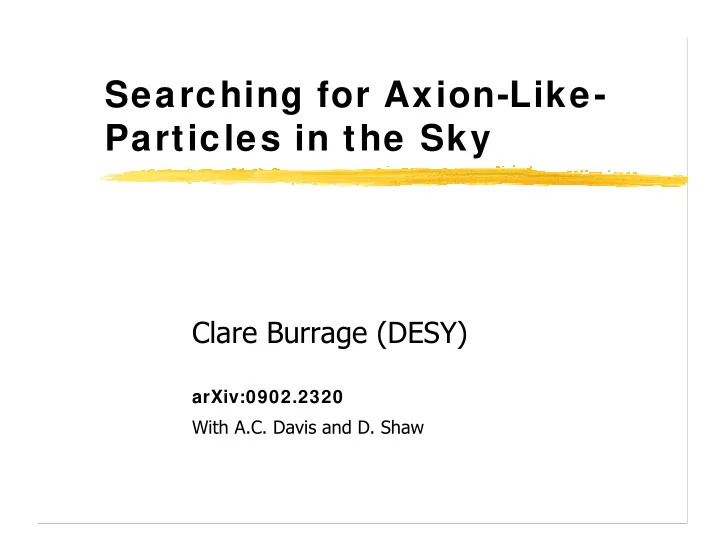

Searching for Axion-Like- Particles in the Sky Clare Burrage (DESY) arXiv:0902.2320 With A.C. Davis and D. Shaw
Scalar Fields After Λ , next most simple explanation for accelerated expansion of the universe is a light scalar field (If unknown physics solves the Cosmological Constant problem) Naively expect this field to couple to standard model particles This should produce observable effects!
Outline Axion Like Particles Photon-ALP Mixing Effects on Astronomical Observations Using the Distribution of Luminosities to Investigate Photon-ALP Mixing Conclusions
ALPs and Dark Energy Consider scalars and pseudoscalars coupling to photons through the terms Such particles have been proposed as Dark Energy candidates: Coupled Quintessence (Amendola 1999) Chameleon Dark Energy (Khoury, Weltman 2004, Brax, Davis, van de Bruck 2007 ) Axionic Dark Energy (Carroll 1998, Kim, Nilles 2003) ...
ALPs and Dark Energy We consider fields with Pseudoscalars: limits from observations of neutrino burst from SN 1987A (Ellis, Olive 1987) Scalars: limits from fifth force experiments (Smullin et al. 2005) Chameleons: limits from the structure of starlight polarisation (CB, Davis, Shaw 2008)
Photon-ALP Mixing Mixing when photons propagate through background magnetic fields Probability of mixing Mixing with only one photon polarisation state Also induces polarisation Strong Mixing limit: (Raffelt, Stodolsky 1987)
Astrophysical Photon-ALP Mixing Laboratory searches (BRFT, BMV, PVLAS, QSQAR...) so far unsuccessful Magnetic fields known to exist in galaxies/galaxy clusters These magnetic fields made up of a large number of magnetic domains field in each domain of equal strength but randomly oriented ALP mixing changes astrophysical observations Non-conservation of photon number alters luminosity Creation of polarisation
Strong Mixing in Galaxy Clusters Galaxy cluster: Magnetic field strength Magnetic coherence length Electron density Plasma frequency Typical no. domains traversed Strong mixing if Requires
Effects of Strong Mixing on Luminosity After passing through many domains power is, on average, split equally between ALP and two polarisations of the photon Average luminosity suppression = 2/3 (Csáki, Kaloper, Terning 2001) Difficult to use this to constrain mixing because knowledge of initial luminosities is poor Single source: If ; averaged over many paths
Effects of Strong Mixing on Luminosity Probability distribution function for f(c) 0 0.2 0.4 0.6 0.8 1 c
Luminosity Relations Empirically established relations between high frequency luminosity and some feature at lower frequency e.g. peak energy, or luminosity Standard relation High frequency Low frequency feature feature If Gaussian noise If strong ALP-photon mixing in addition Detection possible if Gaussian component smaller
Luminosity Relations Use the likelihood ratio test to compare Gaussian Vs Gaussian + ALP strong mixing Likelihood ratio Against ALPsm For ALPsm r<-6 r>6 Strong Evidence r<-10 r>10 Very Strong Evidence For GRB and Blazar relations find |r|<0.75
Active Galactic Nuclei Strong correlation between 2 keV X-ray luminosity and optical luminosity (~5eV) Use observations of 77 AGN from COMBO-17 and ROSAT surveys (z=0.061-2.54) (Steffen et al. 2006) Likelihood ratio r 14 Assuming initial polarisation r>11 Allowing all polarisations Is this really a preference for ALPsm? Or just an indication of more structure in the scatter?
Fingerprints 10 5 bootstrap resamplings (with replacement) of the data - all samples 77 data points Compute the central moments of the data is the standard deviation is the skewness of the data … Compare this with simulations of the best fit Gaussian and ALPsm models
Fingerprints
Fingerprints
Conclusions If dark energy couples to photons it behaves as an ALP ALPs mix with photons in magnetic fields Scatter in astrophysical luminosity relations can be used to study this mixing Applied to AGN this shows very strong evidence for ALP strong mixing over Gaussian scatter Visualisations of the data show strong qualitative similarity to best fit ALP mixing model
Other hints for ALPs Ultra-high-energy cosmic rays from BL Lacs (Fairbairn, Rashba, Troitsky 2009) Anomalously large transparency of the Universe to gamma rays (Roncadelli, De Angelis, Mansutti 2009) White dwarf cooling (Isern, Catalán, García-Berro, Torres 2008) Starlight polarisation (chameleons) (CB, Davis, Shaw 2008)
GRBs and Blazars GRBs: gamma-ray luminosity can be correlated with: spectral lag, variability of light curve, peak energy… 69 GRBs with z=0.17-6.6 (Schaefer 2007) Blazars: gamma-ray luminosity correlated with: radio luminosity, near infra-red luminosity 95 EGRET observations, z=0.02-2.5, for radio (Bloom 2007) 16 blazars with z=0.3-1, for IR (Xie, Zhang, Fan 1997) All these observations have |r|<0.75 statistically insignificant preference for ALPsm
Recommend
More recommend